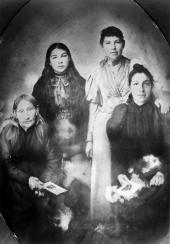
The first generation of Métis women in Saskatchewan were either born to European fur-traders and Indigenous women at posts such as Cumberland House (1775) and Carleton House (1790), or had accompanied their fathers or husbands into the region. Daughters had a variety of experiences depending on the duration of their parent's relationship, the commitment of a father to his family, his social class and affluence, and the cultural traditions that met and mixed in the home. Over time, as the population grew, children of mixed heritage tended to marry each other, blurring and mixing their diverse cultural heritages and creating a new people. Métis girls were expected to be active and helpful, running errands and caring for younger children. Sewing doll dresses and making moccasins from leaves gave way to learning from mothers, aunts and grandmothers in the critical skills of sewing, quillwork, beadwork and embroidery. Women were involved in trapping, harvested wild plants and medicines, fished, hunted birds and small game, tanned hides, processed meat, and made all the clothing and footwear for their families. Their daughters worked beside them.
Mentored learning involved an older, experienced woman performing an action, with the young learner observing, copying the action and doing it independently under careful scrutiny. The process could be quite strict, and young girls were often required to repeat their tasks until successful. At other times, girls were allowed to use their mother's supplies with little direct instruction. Mistakes were met with teasing and laughter, success with praise and compliments. This combination ensured that certain standards were maintained, while creativity and innovation were encouraged. As they grew older, their learning continued as they joined circles of working women who engaged in collaborative projects or worked individually while chatting and telling stories. In this way, women learned to work together and were introduced to the collective values of their community.
Girls tended to marry young, often by their mid-teens, and marriages were usually arranged. If a young man accepted a pair of moccasins made by his future bride, a marriage contract existed. He might also be required to pay a bride's price of trade goods or horses. Winter was the wedding season, and weddings were community celebrations that could last several days. On the prairies, women were wrapped in buffalo robes and carried to elaborately decorated dog sleds, which transported them to a mission where a marriage ceremony could be conducted and later took them on a “wedding trip” to their new home. Motherhood quickly followed marriage. As Christian, particularly Catholic, influences grew, women were pressured to discontinue extended breast-feeding and other forms of traditional birth control. As a result, they had very large families and often died of complications related to childbirth.
Married couples and families were essential socio-economic units. Men and women had complimentary skill sets, and played equally important roles in supporting and sustaining community economies. Men obtained raw materials through the hunt, bringing home meat and hides, which women's skill and labour transformed into pemmican, dry meat, tanned hide and garments for family use or sale. During the fur trade, pemmican, which was often the only food available to workers and travelers, sustained an industry. From 1850 to 1870 there was a considerable market for Métis-style coats, jackets, saddles, and smaller items such as quirts, fire bags, watch pockets, and pouches. Red River cart trains loaded with these goods traveled to consumers, and male traders often moved beyond their family circle for suppliers. Women's production continued to be critical to Métis economies, particularly as men found it increasingly difficult to make a living. In the first half of the 20th century, Métis women in Saskatchewan produced a huge volume of hooked and braided rugs, marketing them from door to door with berries, fish, or garden produce.
While Métis women had little direct political power, they exerted significant influence on husbands, brothers, and particularly sons - by refusing to work, making verbal appeals, and publicly admonishing or encouraging men. Many had engaged in battle, loading and repairing guns, making bullets, often standing just behind the men. Women could also be passionate advocates for peace, speaking as mothers and on behalf of the children. Their spiritual lives blended elements of traditional beliefs with Christianity: many worked tirelessly to support mission work, and devotion intensified after the 1885 resistance and collapse of traditional economies. Older women took particular comfort in religion during a time of profound loss and change. Large crosses became an important part of women's dress, and colours became darker and almost nun-like. Contemporary Métis women are becoming more visible in the political arena, but continue to work primarily at the community level. In the last twenty years, their participation in post-secondary education has dramatically increased, and Saskatchewan Métis women, as writers and artists, stand among the best in Canada.
Sherry Farrell Racette
Print EntryHOME | BROWSE BY SUBJECT | ENTRY LIST (A-Z) | IMAGE INDEX | CONTRIBUTOR INDEX | ABOUT THE ENCYCLOPEDIA | SPONSORS TERMS OF USE | COPYRIGHT © 2006 CANADIAN PLAINS RESEARCH CENTER, UNIVERSITY OF REGINA | POWERED BY MERCURY CMS |
|||
| This web site was produced with financial assistance provided by Western Economic Diversification Canada and the Government of Saskatchewan. |
|||
 |
 |
 |
 |
| Ce site Web a été conçu grâce à l'aide financière de Diversification de l'économie de l'Ouest Canada et le gouvernement de la Saskatchewan. |
|||